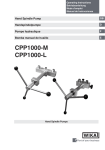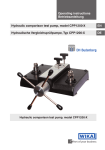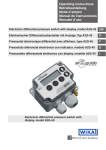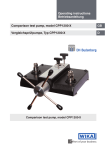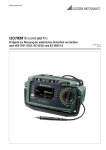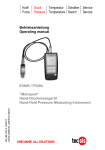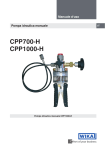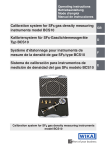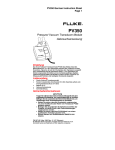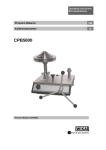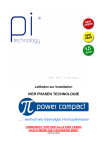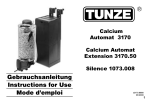Download CPP1000-M CPP1000-L - AV Measurement & Control (India)
Transcript
Operating Instructions Betriebsanleitung Hand Spindle Pump GB Handspindelpumpe D CPP1000-M CPP1000-L Hand Spindle Pumps GB Operating Instructions Hand Spindle Pump D Betriebsanleitung Handspindelpumpe Page 3 - 22 Seite 23 - 42 Warning! This Symbol warns you against actions that can cause injury to people or damage to the instrument. WIKA Operating Instructions Hand Spindle Pump 11178035 06/2006 GB/D Information This symbol provides you with information, notes and tips. Hand Spindle Pump CPP1000-M/-L Contents 1. 1.1 2. 2.1 2.2 3. 3.1 3.1.1 3.1.2 3.1.3 3.1.4 3.2 3.3 3.4 4. 5. 5.1 5.2 6. 4 4 6 6 6 7 7 7 7 8 9 10 11 13 13 15 15 15 16 20 21 22 43 11178035 06/2006 GB/D 7. 8. 9. 10. General General safety instructions Product description General product information Arrangement of control elements Commissioning and operation Preparation Setting up the device Filling in of operating liquid Connecting the pressure measuring instruments (reference and test specimen) Venting the system Operation Handling the CPP1000-M/-L with shut-off valve for test connection Disassembly Troubleshooting measures Maintenance and care Wear parts Changing the operating liquid Mounting instruction for shut-off valve for test connection and fine adjustment valve Specifications Dimensions Order data / Accessories Addresses GB WIKA Operating Instructions Hand Spindle Pump Hand Spindle Pump CPP1000-M/-L GB 1. General In the following chapters detailed information on the hand spindle pump CPP1000-M/-L and its proper use can be found. Should you require further information, or should there be problems which are not dealt within detail in the operating instructions, please contact the address listed on the last page. The warranty period for the hand spindle pump CPP1000-M/-L is 24 months according to the general terms of supply of ZVEI. The warranty is void if the appliance is put to improper use or if the operating instructions are not observed or if an attempt is made to open the appliance or to release attachment parts or threaded connections. We also point out that the content of these operating instructions neither forms part of an earlier or existing agreement, assurance or legal relationship nor is meant to change these. All obligations of WIKA Alexander Wiegand GmbH & Co. KG result from the respective sales contract and the general business terms of WIKA Alexander Wiegand GmbH & Co. KG. WIKA is a registered trade mark of WIKA Alexander Wiegand GmbH & Co. KG. Names of companies or products mentioned in this handbook are registered trade marks of the manufacturer. We reserve the right to effect reasonable changes on the basis of technical improvements. Any reproduction of this manual or parts thereof by any means is prohibited. © 2006 Copyright WIKA Alexander Wiegand GmbH & Co. KG Read these operating instructions carefully prior to operating the hand spindle pump CPP1000-M/-L. Its trouble-free operation and reliability cannot be guaranteed unless the safety advice given in this manual is followed when using the device. 1. The hand spindle pump CPP1000-M/-L must only be operated by trained and authorised personnel who know the manual and can work according to them. WIKA Operating Instructions Hand Spindle Pump 11178035 06/2006 GB/D 1.1 General safety instructions Hand Spindle Pump CPP1000-M/-L 2. Trouble-free operation and reliability of the device can only be guaranteed GB so long as the conditions stated under „Setting up the device“ are taken into consideration. 3. The hand spindle pump CPP1000-M/-L always has to be handled with the care required for a precision instrument (protect from humidity, impacts and extreme temperatures). The pump must be handled with care (don‘t throw, hit, etc.) and protect them from contamination. By no means apply any force to the operating elements (star handle, shut-off valve, test connections) of the hand spindle pump CPP1000-M/-L. 4. If the device is moved from a cold to a warm environment, you should therefore ensure the device temperature has adjusted to the ambient temperature before trying to put it into operation. 5. If the equipment is damaged and might no longer operate safely, then it should be taken out of use and securely marked in such a way that it is not used again. Operator safety may be at risk if: n There is visible damage to the device. n The device is not working as specified. n The device has been stored under unsuitable conditions for an extended period of time. If there is any doubt, please return the device to the manufacturer for repair or maintenance. 11178035 06/2006 GB/D 6. Customers must not attempt to alter or repair the device themselves. If the instrument is opened or attachment parts or the threaded connections are released, its trouble-free operation and reliability is impaired and endangers the operator. Please return the device to the manufacturer for any repair or maintenance. 7. Use original seals only in the device. 8. Any operation not included in the following instructions or outside the specifications must not be attempted. WIKA Operating Instructions Hand Spindle Pump Hand Spindle Pump CPP1000-M/-L GB 2. Product description 2.1 General product information n Application Hand spindle pumps are used to generate pressures for checking, adjusting and calibrating mechanical and electronic pressure measuring instruments by comparative measurements. These pressure tests may be carried out in laboratories, workshops or on site at the measuring point. n Functionality If the instrument to be tested and a sufficiently accurate reference measuring instrument are connected up to the test pump, the same pressure is applied to the two measuring instruments when the hand spindle pump is operated. By comparing the two measured values at random pressure values, the accuracy can be verified or the instrument under test can be adjusted. The hand spindle pump is equipped with a precision spindle to make it possible to approach measuring points exactly. The CPP1000-M/-L is particularly notable for the rotating spindle that only runs inside the body of the pump. This eliminates the negative effect of a bending torque on a spindle turning outside the body and offers the advantage, especially for use in the field, that the dimensions of these hand spindle pumps do not change during operation due to the spindle turning. 2.2 Arrangement of control elements Reservoir and shut-off valve Reservoir (sealed) and shut-off valve Fine adjustment valve 2 Pressure connections for gauges G½ (reference and test specimen) 2 Through holes 6.4 mm for stationary fastening Star handle CPP1000-M CPP1000-L WIKA Operating Instructions Hand Spindle Pump 11178035 06/2006 GB/D Spring-loaded thrust pad Hand Spindle Pump CPP1000-M/-L 3. Commissioning and operation GB 3.1 Preparation 3.1.1 Setting up the device n Set up the hand spindle pump on a solid surface. Avoid unsafe mounting conditions. If necessary, it can be secured by mounting on a baseplate or workbench using appropriate screws. Two drillings (Ø 6.4 mm) are available on the front flange for this purpose. n Place the star handle with knobs onto the spindle pump. Ensure that the spring-loaded thrust pad engages into the star handle bushing. 3.1.2 Filling in of operating liquid (first commissioning) As an operating liquid only the following are suitable for the CPP1000-M/-L: n n Acid-free hydraulic oil Distilled water Other pressure transmitting media are available on request. Fill the hand spindle pump with a suitable operating liquid as follows: 11178035 06/2006 GB/D n Turn the spindle completely clockwise. n Open the shut-off valve and unscrew it completely, then remove the top cover of the reservoir. n Pour the operating liquid carefully and slowly, alternating between both pressure connections. You can monitor how the operating liquid settles into the reservoir. Pour the liquid into the pressure connections until the reservoir is ½ to ¾ full. WIKA Operating Instructions Hand Spindle Pump Hand Spindle Pump CPP1000-M/-L GB 3.1.3 Connecting the pressure measuring instruments (reference and test specimen) n The pressure connections have G½ female threads. When you are calibrating devices with different connection threads, please use appropriate threaded adapters (see chapter 9. Accessories). n Connect the reference pressure measuring instrument and the instrument to be inspected (test specimen), one to each of the CPP1000-M/-L two pressure connections. The pressure connections are free-rotating, so that you can align the instruments in such a way that a proper reading is ensured. An O-ring seal is already fitted, so no additional sealing material is required. Hand tightening is sufficient to make a proper seal. O-ring seal n To calibrate instruments with back mounting connection there is an angle connection 90° available (see chapter 9. Accessories). For calibration cycles with larger volumes, it is advisable to fill the test specimen/reference with the operating liquid beforehand or to use the shut-off valve for test connection, which is available as an accessory (see chapter 9. Accessories). WIKA Operating Instructions Hand Spindle Pump 11178035 06/2006 GB/D Check the O-ring seal in the pressure connections for proper seat and for any wear. Replace, if necessary (See chapter 9. Accessories). Please see to it that each instrument mounted to the test pump must be clean inside. Hand Spindle Pump CPP1000-M/-L GB Example: A calibration assembly with the CPP1000-M/-L and a CPH6000 process calibrator as the reference instrument and a pressure transmitter as the test specimen 3.1.4 Venting the system n Put the reservoir cap back on and fit the shut-off valve. However, leave the valve open! n Turn the star handle anticlockwise until fully out/open. n Close the valve. 11178035 06/2006 GB/D 1) Turn the star handle clockwise until the test specimen and/or the reference indicates a pressure of approx. 50 to 100 bar. If, after the spindle has been fully wound in in a clockwise direction, there is no increase in pressure, then the connected test volume is too large, and the instruments will need pre-filling with operating liquid before being attached to the pump or the shut-off valve for test connection, which is available as an accessory, is to be used (see chapter 9. Accessories). 2) Fully open the valve, slowly and carefully. You will notice any escaping air bubbles. 3) Close the valve again. WIKA Operating Instructions Hand Spindle Pump Hand Spindle Pump CPP1000-M/-L GB 4) Turn the star handle further in a clockwise direction, until the test specimen and/ or the reference again indicates a pressure value of approx. 50 to 100 bar. 5) Fully open the valve, slowly and carefully. If necessary, check again if any air bubbles escape. 6) Close the valve again. 7) Turn the star handle anticlockwise all the way out. 8) Open the valve. 9) After approximately 10 seconds, close the valve. n Repeat steps 1) to 9) again, if necessary. The CPP1000-M/-L hand spindle pump is now ready to use. For test specimens or reference instruments with particularly large volumes we recommend filling them with operating liquid beforehand or using the shut-off valve for test connection, which is available as an accessory (see chapter 9. Accessories). 3.2 Operation n We recommend unscrewing the spindle completely when you start to record measurement values, (turning anticlockwise) to allow enough volume for measurements. n To increase the test pressure turn the star handle clockwise. n To decrease the test pressure turn the star handle anticlockwise. n The use of a fine adjustment valve (CPP1000-L availabel as standard) allows to make fine adjustments to the initial pressure setting by turning the fine adjustment valve in or out. n The display of the instrument under test can be compared with the reference measuring instrument at each individual calibration point. Since small amounts of air are always compressed in the system together with the medium, the test pressure that has been generated first drops off slightly. After this it must be readjusted. 10 WIKA Operating Instructions Hand Spindle Pump 11178035 06/2006 GB/D The maximum permissible pressure for the CPP1000-M/-L is 1000 bar. Higher pressures may damage the pump. The reference instrument, test specimen and any connecting tubes that are used must not be subjected to pressures above the maximum permissible level. Hand Spindle Pump CPP1000-M/-L At higher pressures a longer waiting time before stable operating conditions are reached is to be expected than at lower pressures. GB NEVER open the shut-off valve suddenly while the system is pressurised. The valve may be opened only if the spindle has been fully unscrewed in an anticlockwise direction. (exception: chapter 3.1.4 Venting the system) Turn the spindle pump anticlockwise as far as the end-stop to vent the system completely and only then open the shut-off valve. You can now change the test specimen (and/or the reference instrument). 3.3 Handling the CPP1000-M/-L with shut-off valve for test connection When calibrating instruments with large volume a shut-off valve for the test connections is a useful accessory (see chapter 9. Accessories). This shut-off valve makes it possible to draw pressure medium from the reservoir into the pump and into the connected test gauges. So it is not necessary to fill pressure medium into the test specimen or the reference instrument before connecting to the pump. For devices under test and reference instruments with a large volume we recommend a shut-off valve on each test connection. When a fine adjustment valve (available as standard with CPP1000-L) is used, only one shut-off valve can be mounted for the test connection. 4 5 2 11178035 06/2006 GB/D 3 1 (1) (2) (3) (4) (5) Star handle Shut-off valve for reservoir Shut-off valve for test connections Test specimen Reference instrument WIKA Operating Instructions Hand Spindle Pump 11 Hand Spindle Pump CPP1000-M/-L GB Mounting and preparation/Venting the system n Mount the shut-off valve (3) in the surface mounting flange at the side of the pump in exchange for the screw plug mounted as standard. During this process the pump must be free of pressure (see chapter 6. Mounting instruction). n Mount the test specimen (4) on the test connection. n Mount the reference instrument (5) on the second test connection. n Put the reservoir cap back on and fit the shut-off valve (2). However, leave the valve open! n Close the shut-off valve(s) for test connections (3) by turning them clockwise. n Turn the star handle anticlockwise until fully out/open. 1) Close the shut-off valve on the reservoir (2). 2) Open the shut-off valve(s) for test connections (3) by turning them counterclockwise (less than one complete turn is suffi-cient). 3) Turn the star handle (1) clockwise until the test specimen and/or the reference indicates a pressure of appro. 50 to 100 bar. 4) Fully open the valve (2), slowly and carefully. If necessary, check again if any air bubbles escape. 5) Close the shut-off valve on the reservoir (2). 6) Close the shut-off valve(s) for test connections (3) by turning them clockwise. 7) Turn the star handle anticlockwise all the way out. n Repeat steps 1) to 7) several times. n Open the shut-off valve (3) on the test specimen and close the shut-off valve on the reservoir (2). n Turn the star handle clockwise. Operating liquid is pressed into the connected test specimen. n If the connected instrument has still not been filled enough or if the required pressure has still not been reached, close the shut-off valve on the test specimen (3). n Open the shut-off valve on the reservoir (2) and turn the star handle counterclockwise as far as it will go. New pressure medium is drawn from the reservoir into the cylinder of the pump. n Close shut-off valve on the reservoir (2). n Open shut-off valve on the test specimen (3). n Turn the star handle clockwise again. n Repeat the process described here until the required pressure is reached. 12 WIKA Operating Instructions Hand Spindle Pump 11178035 06/2006 GB/D Operation Hand Spindle Pump CPP1000-M/-L GB 3.4 Disassembly n After all pressure points have been recorded (at the end of the test specimen calibration), fully unscrew the spindle and open the valve. n Now you can disconnect the test specimen (and if necessary the reference instrument) from its pressure connection. Disconnect the test specimen and/or the reference instrument only after the pressure within the hand spindle pump has been completely relieved. n In order to remove the star handle from the spindle pump, the spring-loaded thrust pad must be pressed downward with the aid of a small screwdriver, or a ball-point pen. The star handle may now be pulled off toward the front. n When transporting the hand spindle pump it is recommended to empty the pump fully. The test connections should be sealed with plugs (see chapter 9. Accessories). Spring-loaded thrust pad 4. Troubleshooting measures 11178035 06/2006 GB/D If faults cannot be eliminated will the aid of the operating istructions, the system must be put out of operation immediateley and the manufacturer i to be informed. Repairs must only be carried out by the manufacturer. Internventions and changes on the appliance are not allowed. In case of faults caused by defects of the hydraulic equipment the operators must inform their superiors immediately and call in the qualified and authorised technical staff for maintenance. WIKA Operating Instructions Hand Spindle Pump 13 Hand Spindle Pump CPP1000-M/-L GB Table: Fault description and measures Type of fault: Measures: I. Unable to build up pressure/leak in n Close shut-off valve of the reservoir correctly the system n Check whether the seals have been placed in the pressure connections and whether they are properly positioned. II. Unable to build up pressure, or maximum pressure cannot be reached n After the mounting of the test specimen and the reference instrument, air may be trapped in the system. Please note: The system should be vented before beginning with calibration. For this purpose, proceed according to chapters 3.1.2 to 3.1.4. n Afterwards, build the pressure back up. NOTE: For calibration cycles with larger volumes, it is advisable to fill the test specimen, and if necessary, the reference instrument with operating liquid beforehand or to use the shut-off valve for test connection, which is available as an accessory (see chapter 9. Accessories). III. Slow pressure drop n Leak in the system, see point I. n If small amounts of air are always compressed in the system together with the medium, the test pressure that has been generated first drops off slightly. After this it must be readjusted. n After the clamping of the test specimen and the reference instrument, air may be trapped in the system, see point II. n Afterwards, build the pressure back up. Further help can be found through WIKA‘s Test & Calibration Technolgy Department. 14 WIKA Operating Instructions Hand Spindle Pump 11178035 06/2006 GB/D n If the system is pressurised quickly, it takes a certain time (<1 minute) until it can stabilise thermally. The pressure should then be adjusted accordingly. Hand Spindle Pump CPP1000-M/-L 5. Maintenance and care GB The hand spindle pump can be easily cleaned by wiping down with a damp cloth. No maintenance tasks should be undertaken on the spindle pump. With any clearly visible signs of wear, it must be sent back to the manufacturer for refurbishment (after cost estimate). 5.1 Wear parts The O-rings in the pressure connections are subjected to wear. Both O-rings must be checked for proper seat and any wear before any calibrating is performed. If necessary, the O-rings must be replaced at regular intervals, or whenever necessary (see chapter 9. Accessories). Use original seals only. Seals having deviant measurements, or materials, or material grades, may cause damage to the device and test specimen or to the reference instrument, and pose a danger for the operator. 5.2 Changing the operating liquid The hydraulic oil should be changed whenever visible contamination is present. Removing the operating liquid Open the shut-off valve, by unscrewing it completely. Take the transparent lid off. Draw the liquid out of the reservoir e.g. with a suitable syringe. In addition, any small residual quantities of oil can be drawn off at the pressure connections, by slowly turning the spindle pump, with the shut-off valve closed. n Minute amounts of oil residue may remain in the piping 11178035 06/2006 GB/D n n n n Waste oil must be disposed of according to legal requirements. n To refill and vent the system follow the instructions already given in chapter 3.1.2 to 3.1.4. WIKA Operating Instructions Hand Spindle Pump 15 Hand Spindle Pump CPP1000-M/-L GB 6. Mounting instruction for shut-off valve for test connection and fine adjustment valve The mounting instruction describes the subsequent mounting of the shut-off valve for test connection (Order No. 11208384) or of the fine adjustment valve (Order No. 11248351). The valves can be mounted at the side of the back flange in exchange for the blind plugs which are installed as standard. CPP1000-L CPP1000-M The following combinations are possible for the individual pump versions. Shut-off valve for test connection 1 0 1 2 Fine adjustment valve with with with with Shut-off valve for test connection 0 1 1 0 Fine adjustment valve 1 with installed as standard 0 with installed as standard 11178035 06/2006 GB/D If only one instrument (reference gauge or test item) with large volume is mounted on the CPP1000-M, only one shut-off valve for test connection is needed. If both gauges (reference and test item) have large volumes, the usage of two shut-off valves is recommended. When 2 shut-off valves are used, it is not possible to mount a fine adjustment valve. 16 WIKA Operating Instructions Hand Spindle Pump Hand Spindle Pump CPP1000-M/-L GB For mounting you need the following tools: n Allen wrench 8 mm n Flat wrench SW 27 n Tweezers Please check the scope of supply: n 1 pc. valve n 1 pc. O-ring (green) and 2 pc. supporting rings (PTFE) (only with shut-off valve; Order No. 11208384) Side view of hand spindle pump showing the blind plug with hexagon socket blind plug with hexagon socket 11178035 06/2006 GB/D Open the blind plug using an 8 mm allen wrench and dismount the blind plug completely. WIKA Operating Instructions Hand Spindle Pump 17 Hand Spindle Pump CPP1000-M/-L GB If the blind plug is removed completely, a small cylindrical body, made of red plastic, is visible. This plastic body is to reduce the internal volume of the pump if a shut-off valve or fine adjustment valve is not used / mounted. Remove the red cylindrical body using tweezers or blow it out through the open test connection using compressed air. Now the three rings have to be placed in the pump (only with shut-off valve; Order No. 11208384). You may not place the three rings on the mandrel of the valve, you must place the gasket rings inside the pump, according to following instructions: 11178035 06/2006 GB/D First, insert one of the two supporting rings (made of white PTFE) (only with shut-off valve; Order No. 11208384). Make sure that the supporting ring is fitted well. 18 WIKA Operating Instructions Hand Spindle Pump Hand Spindle Pump CPP1000-M/-L GB Now insert the green O-Ring (only with shut-off valve; Order No. 11208384). Make sure that the O-ring is fitted well. At last, insert the 2nd. support ring (white PTFE) (only with shut-off valve; Order No. 11208384). Make sure that also this support ring is fitted well. Now screw in the shut-off valve or the fine adjustment valve. Pull tight the valve using a flat wrench 27 mm. This parts are left over and may be depolluted: 11178035 06/2006 GB/D n blind plug n red cylindrical body WIKA Operating Instructions Hand Spindle Pump 19 Hand Spindle Pump CPP1000-M/-L GB 7. Specifications CPP1000-M Pressure range bar CPP1000-L 0 ... 1000 Medium Oil / distilled water 1) Pressure connections 2 x G ½“ female thread, rotating, with o-ring Distance of the test connections mm 200 115 Liquid container cm³ 110 55 Piston diameter mm 8 Swept volume per revolution cm³ approx. 0.1 Overall swept volume cm³ approx. 3.9 Pressure fine adjustment option, see accessories lateral fine adjustment valve Required moment at - 250 bar Nm 2.0 - 500 bar Nm 4.0 - 1000 bar Nm 8.0 Material - Piston Stainless steel - Cylinder Brass - Rear flange Aluminium - Sealing gaskets FKM and NBR; optional EPDM Stationary fastening two through holes in the front flange Ø 6.4 mm Dimensions mm 420 (L) x 280 (W) x 103 (H) 420 (L) x 240 (W) x 103 (H) Weight kg 6.3 5,6 11178035 06/2006 GB/D 1) Other pressure transmitting media on request. 20 WIKA Operating Instructions Hand Spindle Pump Hand Spindle Pump CPP1000-M/-L 11178035 06/2006 GB/D 8. Dimensions GB 2 x Ø 6.4 CPP1000-L WIKA Operating Instructions Hand Spindle Pump CPP1000-M 21 Hand Spindle Pump CPP1000-M/-L Hand spindle pump CPP1000-M/-L Order No. 12401447 Hand spindle pump CPP1000-L, portable version incl. fine adjustment valve and sealed tank cap Order No. 12677133 Operating liquid for CPP1000 and CPP1600 test pump series in plastic bottle, content 1 litre Order No. 2099882 Shut-off valve for test connection for an easy filling of instruments with a large volume with pressure transmitting medium directly on the hand spindle pump. Max. permissible pressure: 1000 bar For devices under test and reference instruments with a large volume we recommend 2 shut-off valves. Order No.11208384 Fine adjustment valve for subsequent mounting into Model CPP1000-M; enables the exact setting up of pressure values Order No. 11248351 Blind plug G ½ male thread, material: brass Order No. 11155230 Set of O-rings consisting of 10 spare sealings for pressure ports, material: FKM/FPM Order No. 12422487 Threaded adapter G ½ male thread on G E female thread, material: brass Order No. 9090207 Threaded adapter G ½ male thread on G ¼ female thread, material: brass Order No. 9090231 Threaded adapter G ½ male thread on G F female thread, material: brass Order No. 9090266 Threaded adapter G ½ male thread on M20 x 1.5 female thread, material: brass Order No. 9090355 Threaded adapter G ½ male thread on ¼ NPT female thread, material: brass Order No. 0187119 Threaded adapter G ½ male thread on ½ NPT female thread, material: brass Order No. 0187143 Angle connection 90° for test specimens with back mounting connection Order No. 1564838 22 WIKA Operating Instructions Hand Spindle Pump 11178035 06/2006 GB/D GB 9. Order data / Accessories Handspindelpumpe CPP1000-M/-L Inhalt D 1. 1.1 2. 2.1 2.2 3. 3.1 3.1.1 3.1.2 3.1.3 3.1.4 3.2 3.3 3.4 4. 5. 5.1 5.2 6. 7. 8. 9. 10. Allgemeines Allgemeine Sicherheitshinweise Produktbeschreibung Allgemeine Produktinformationen Anordnung der Bedienelemente Inbetriebnahme und Betrieb Vorbereitung Aufstellung des Gerätes Befüllen des Systems mit Betriebsflüssigkeit Anschluss der Druckmessgeräte (Referenz und Prüfling) Entlüften des Systems Betrieb Handhabung der CPP1000-M/-L mit Prüfanschluss/Absperrventil Abbau Maßnahmen bei Störungen Pflege und Wartung Verschleißteile Austausch der Betriebsflüssigkeit Einbauanleitung für Absperrventil für Prüfanschluss und Feinregulierventil Technische Daten Abmessungen Bestelldaten / Zubehör Adressen 24 24 26 26 26 27 27 27 27 28 29 30 31 33 33 35 35 35 36 40 41 42 43 11178035 06/2006 GB/D Information Dieses Zeichen gibt Ihnen Informationen, Hinweise oder Tipps. Warnung! Dieses Symbol warnt Sie vor Handlungen, die Schäden an Personen oder am Gerät verursachen können. WIKA Betriebsanleitung Handspindelpumpe 23 Handspindelpumpe CPP1000-M/-L 1. Allgemeines D In den folgenden Kapiteln erhalten Sie nähere Informationen zur Handspindelpumpe CPP1000-M/-L und ihren ordnungsgemäßen Einsatz. Sollten Sie weitere Informationen wünschen, oder treten besondere Probleme auf, die in der Betriebsanleitung nicht ausführlich behandelt werden, erhalten Sie Auskunft unter den auf der letzten Seite aufgelisteten Adressen. Die Gewährleistungszeit für die Handspindelpumpe CPP1000-M/-L beträgt 24 Monate nach den Allgemeinen Lieferbedingungen des ZVEI. Sämtliche Gewährleistungsansprüche verfallen, bei unsachgemäßer Handhabung bzw. bei Nichtbeachtung der Betriebsanleitungen oder bei dem Versuch das Gerät zu öffnen bzw. Anbauteile oder Verschraubungen zu lösen. Außerdem weisen wir darauf hin, dass der Inhalt dieser Betriebsanleitung nicht Teil einer früheren oder bestehenden Vereinbarung, Zusage oder Rechtsverhältnisses ist oder diese abändern soll. Sämtliche Verpflichtungen der WIKA Alexander Wiegand GmbH & Co. KG ergeben sich aus dem jeweiligen Kaufvertrag und den Allgemeinen Geschäftsbedingungen der WIKA Alexander Wiegand GmbH & Co. KG. WIKA ist ein eingetragenes Warenzeichen der WIKA Alexander Wiegand GmbH & Co. KG. Firmen- oder Produktnamen, die in diesem Handbuch erwähnt werden, sind eingetragene Warenzeichen dieser Hersteller. Zumutbare Änderungen aufgrund technischer Verbesserungen behalten wir uns vor. Eine Vervielfältigung dieses Handbuches oder Teilen davon ist untersagt. © 2006 Copyright WIKA Alexander Wiegand GmbH & Co. KG Lesen Sie diese Bedienungsanleitung sorgfältig, bevor Sie die Handspindelpumpe CPP1000-M/-L einsetzen. Die Funktion und Betriebssicherheit des Gerätes kann nur dann gewährleistet werden, wenn die Sicherheitshinweise der Bedienungsanleitung beachtet werden. 24 WIKA Betriebsanleitung Handspindelpumpe 11178035 06/2006 GB/D 1.1 Allgemeine Sicherheitshinweise Handspindelpumpe CPP1000-M/-L 1. Die Handspindelpumpe CPP1000-M/-L darf nur von dafür ausgebildeten und befugten Personen bedient werden, die die Bedienungsanleitung kennen und danach arbeiten können! D 2. Die einwandfreie Funktion und Betriebssicherheit der Handspindelpumpe CPP1000-M/-L kann nur unter Berücksichtigung der im Kapitel “Aufstellung des Gerätes” beschriebenen Bedingungen eingehalten werden. 3. Die Handspindelpumpe CPP1000-M/-L ist stets mit der für ein Präzisionsgerät erforderlichen Sorgfalt zu behandeln (vor Nässe, Stößen und extremen Temperaturen schützen). Die Pumpe muss pfleglich behandelt werden (nicht werfen, aufschlagen, usw.) und ist vor Verschmutzung zu schützen. Vermeiden Sie unbedingt jegliche Gewalteinwirkung auf die Bedienungselemente (Spindelrad, Ventil, Prüflingsanschlüsse) der Handspindelpumpe CPP1000-M/-L. 4. Wird das Gerät von einer kalten in eine warme Umgebung transportiert, muss die Angleichung der Gerätetemperatur an die Raumtemperatur vor einer erneuten Inbetriebnahme abgewartet werden. 5. Wenn anzunehmen ist, dass das Gerät nicht mehr gefahrlos betrieben werden kann, so ist es außer Betrieb zu setzen und vor einer Wiederinbetriebnahme durch Kennzeichnung zu sichern. Die Sicherheit des Benutzers kann durch das Gerät beeinträchtigt sein, wenn es zum Beispiel: 11178035 06/2006 GB/D n Sichtbare Schäden aufweist n Nicht mehr wie vorgeschrieben arbeitet n Längere Zeit unter ungeeigneten Bedingungen gelagert wurde Im Zweifelsfall das Gerät grundsätzlich an den Hersteller zur Reparatur bzw. Wartung einschicken. 6. Es dürfen am Gerät keine Veränderungen oder Reparaturen vom Kunden vorgenommen werden. Das Öffnen des Gerätes oder das Lösen von Anbauteilen, oder von Verschraubungen beeinträchtigt die Funktions- und Betriebssicherheit und stellt eine Gefahr für die Bedienperson dar. Zur Wartung oder Reparatur muss das Gerät zum Hersteller eingesandt werden. 7. Es dürfen nur Original-Dichtungen im Gerät verwendet werden. 8. Ein anderer Betrieb als der in der folgenden Anleitung beschriebene oder außerhalb der Spezifikation, ist bestimmungswidrig und muss daher ausgeschlossen werden. WIKA Betriebsanleitung Handspindelpumpe 25 Handspindelpumpe CPP1000-M/-L 2. Produktbeschreibung D 2.1 Allgemeine Produktinformationen n Einsatz Handspindelpumpen dienen zur Druckerzeugung für die Überprüfung, Justage und Kalibrierung von mechanischen und elektronischen Druckmessgeräten durch Vergleichsmessungen. Diese Druckprüfungen können stationär im Labor oder Werkstatt, oder vor Ort an der Messstelle stattfinden. n Funktionsweise Schließt man das zu prüfende Gerät und ein hinreichend genaues ReferenzDruckmessgerät an der Handspindelpumpe an, so wirkt bei Betätigung der Pumpe auf beide Messgeräte der gleiche Druck. Durch Vergleich der beiden Messwerte bei beliebigen Druckwerten kann eine Überprüfung der Genauigkeit bzw. eine Justage des zu prüfenden Druckmessgerätes erfolgen. Zum exakten Anfahren der Messpunkte ist die Handspindelpumpe CPP1000-M/-L mit einem fein zu betätigenden Spindelrad ausgestattet. Die CPP1000-M/-L zeichnet sich durch eine innerhalb des Pumpenkörpers laufende Drehspindel aus. Damit entfällt ein nachteiliges Biegemoment auf eine herausgedrehte Spindel und speziell für einen Einsatz vor Ort besteht außerdem der Vorteil, dass sich die Abmessungen der Handspindelpumpe während des Betriebs durch Drehen der Spindel nicht verändern. 2.2 Anordnung der Bedienelemente Mediumvorratsbehälter und Absperrventil Mediumvorratsbehälter (abgedichtet) und Absperrventil Feinregulierventil 2 Druckanschlüsse G½“ für Messgeräte (Referenz und Prüfling) 2 Bohrungen 6,4 mm für stationäre Befestigung Drehkreuz CPP1000-M 26 CPP1000-L WIKA Betriebsanleitung Handspindelpumpe 11178035 06/2006 GB/D Federdruckstück Handspindelpumpe CPP1000-M/-L 3. Inbetriebnahme und Betrieb 3.1 Vorbereitung D 3.1.1 Aufstellung des Gerätes n Stellen Sie die Handspindelpumpe auf eine feste Unterlage. Vermeinden Sie einen unsicheren Stand. Gegebenenfalls kann eine stationäre Befestigung auf einer Grundplatte oder Werkbank mit geeigneten Schrauben durchgeführt werden, hierzu sind zwei Bohrungen (Ø 6,4 mm) am Vorderflansch vorhanden. n Stecken Sie das Drehkreuz mit den Griffen auf die Spindelpumpe auf. Achten Sie hierbei darauf, dass das Federdruckstück in die Drehkreuzhülse einrastet. 3.1.2 Befüllen des Systems mit Betriebsflüssigkeit (Erst-Inbetriebnahme) Als Betriebsflüssigkeit ist für die CPP1000-M/-L ausschließlich geeignet: n n Säurefreies Hydrauliköl Destilliertes Wasser Andere Druckübertragungsmedien auf Anfrage. 11178035 06/2006 GB/D Befüllen Sie die Handspindelpumpe wie folgt mit geeigneter Betriebsflüssigkeit: n Drehen Sie die Spindel vollständig in Uhrzeigerlaufrichtung ein. n Öffnen Sie das Absperrventil und drehen Sie es vollständig heraus, nehmen Sie den Vorratsbehälter-Deckel ab. n Füllen Sie die Betriebsflüssigkeit vorsichtig und langsam abwechselnd in beide Druckanschlüsse ein. Sie können dabei beobachten, wie die Betriebsflüssigkeit in den Vorratsbehälter austritt. Füllen Sie über die Druckanschlüsse so lange Flüssigkeit ein, bis der Vorratsbehälter zu ½ bis ¾ gefüllt ist. WIKA Betriebsanleitung Handspindelpumpe 27 Handspindelpumpe CPP1000-M/-L 3.1.3 Anschluss der Druckmessgeräte (Referenz und Prüfling) D n Die Druckanschlüsse besitzen ein G ½ Innengewinde Bei Kalibrierung von Geräten mit anderen Anschlussgewinden sind entsprechende Gewindeadapter zu verwenden. (siehe Kapitel 9. Zubehör) n Setzen Sie nacheinander ein Referenz-Druckmessgerät und das zu überprüfende Gerät (Prüfling) in jeweils einen der beiden Druckanschlüsse der CPP1000-M/-L ein. Die Druckanschlüsse sind freilaufend ausgeführt, so dass Sie die Geräte derart ausrichten können, dass eine einwandfreie Ablesung sichergestellt ist. Eine O-Ring-Dichtung ist bereits vorhanden. Sie benötigen kein zusätzliches Dichtmaterial. Ein handfestes Anziehen reicht zum sicheren Abdichten aus. n Um Geräte mit rückseitigen Anschluss zu prüfen, ist als Zubehör ein Winkelanschlussstück erhältlich (siehe Kapitel 9. Zubehör). O-Ring-Dichtung Bei Kalibrierkreisläufen mit größerem Volumen ist ein vorheriges Befüllen von Prüfling/Referenz mit der Betriebsflüssigkeit oder die Verwendung von dem als Zubehör erhältlichen Absperrventil für Prüfanschluss (siehe Kapitel 9. Zubehör) ratsam. 28 WIKA Betriebsanleitung Handspindelpumpe 11178035 06/2006 GB/D Prüfen Sie die O-Ring-Dichtung in den Druckanschlüssen auf richtigen Sitz und Verschleiß, gegebenenfalls austauschen. (siehe Kapitel 9. Zubehör) Es ist darauf zu achten, dass jedes Gerät, das angeschlossen wird, im Inneren sauber ist. Handspindelpumpe CPP1000-M/-L D Beispiel: Kalibrieraufbau CPP1000-M/-L mit ProzessKalibrator CPH6000 als Referenzgerät und Druckmessumformer als Prüfling. 3.1.4 Entlüftung des Systems n Setzen Sie den Vorratsbehälter-Deckel wieder auf und montieren Sie wieder das Ablassventil. Lassen Sie das Ventil jedoch noch geöffnet! n Drehen Sie das Spindelrad entgegen der Uhrzeigerlaufrichtung vollständig heraus. n Schließen Sie das Ventil. 11178035 06/2006 GB/D 1) Drehen Sie das Spindelrad in Uhrzeigerlaufrichtung ein, bis Prüfling und/oder Referenz einen Druckwert von ca. 50 bis 100 bar anzeigt. Wird nach dem vollständigen Eindrehen der Spindel im Uhrzeigersinn kein Druckanstieg erreicht, so ist das angeschlossene Prüfvolumen zu groß und die Geräte müssen vor dem Anschließen an die Pumpe mit Betriebsflüssigkeit vorgefüllt werden oder es ist mit dem als Zubehör erhältlichen Absperrventil für Prüfanschluss (siehe Kapitel 9. Zubehör) zu arbeiten. 2) Öffnen Sie das Ventil ganz langsam und vorsichtig. Sie erkennen austretende Luftbläschen. 3) Schließen Sie wieder das Ventil. 4) Drehen Sie das Spindelrad weiter in Uhrzeigerlaufrichtung ein, bis Prüfling und/ oder Referenz wiederum einen Druckwert von ca. 50 bis 100 bar anzeigt. WIKA Betriebsanleitung Handspindelpumpe 29 Handspindelpumpe CPP1000-M/-L 5) Öffnen Sie das Ventil ganz langsam und vorsichtig. Sie erkennen ggf. nochmals austretende Luftbläschen. 6) Schließen Sie wiederum das Ventil. D 7) Drehen Sie das Spindelrad vollständig entgegen der Uhrzeigerlaufrichtung heraus. 8) Öffnen Sie das Ventil. 9) Schließen Sie das Ventil nach etwa 10 Sekunden. n Wiederholen Sie bei Bedarf die Schritte 1) bis 9) ein weiteres Mal. Die Handspindelpumpe CPP1000-M/-L ist nun einsatzbereit. Bei Prüflingen oder Referenzgeräten mit besonders großem Volumen empfehlen wir das Vorbefüllen mit Betriebsflüssigkeit oder den Einsatz von dem als Zubehör erhältlichen Absperrventil für Prüfanschluss (siehe Kapitel 9. Zubehör). 3.2 Betrieb Der zulässige Druck beträgt bei der CPP1000-M/-L maximal 1000 bar. Größere Drücke können die Pumpe beschädigen. Referenzmessgerät, Prüfling, und evtl. eingesetzte Verbindungsschläuche dürfen nicht durch unzulässig hohen Druck überlastet werden. Wenn im System noch geringe Luftbestandteile mitverdichtet werden, fällt der erzeugte Prüfdruck zunächst etwas ab und ist entsprechend nachzustellen. Bei hohen Drücken ist mit einer größeren Wartezeit zu rechnen als bei kleineren Drücken, bis der Beharrungszustand erreicht ist. 30 WIKA Betriebsanleitung Handspindelpumpe 11178035 06/2006 GB/D n Es empfiehlt sich, die Spindel zu Beginn der Messwertaufnahme immer komplett herauszudrehen (entgegen dem Uhrzeigersinn), um genügend Volumen für die Messung bereit zu stellen. n Zum Erhöhen des Prüfdruckes drehen Sie das Drehkreuz in Uhrzeigerrichtung. n Zum Verringern des Prüfdruckes drehen Sie das Drehkreuz entgegen der Uhrzeigerrichtung. n Bei Einsatz eines Feinregulierventils (bei CPP1000-L standardmäßig vorhanden) kann durch Ein- bzw. Ausdrehen des Ventils die Feineinstellung des voreingestellten Druckes erfolgen. n Die Anzeige des zu prüfenden Druckmessgerätes kann an den einzelnen Kalibrierpunkten mit dem Referenzmessgerät verglichen werden. Handspindelpumpe CPP1000-M/-L Öffnen Sie NIEMALS das Absperrventil schlagartig, solange Druck aufgebaut ist. Das Ventil darf nur dann geöffnet werden, wenn die Spindel vollständig entgegen der Uhrzeigerrichtung herausgeD dreht ist. (Ausnahme: Kapitel 3.1.4 Entlüftung des Systems) n Drehen Sie die Spindelpumpe im Gegen-Uhrzeigersinn bis zum Anschlag, um das System vollständig zu entlasten und öffnen Sie erst dann das Absperrventil. n Sie können nun den Prüfling (und/oder das Referenzgerät) wechseln. 3.3 Handhabung der CPP1000-M/-L mit Prüfanschluss/Absperrventil Bei der Kalibrierung von großvolumigen Geräten ist ein Absperrventil für die Prüfanschlüsse ein nützliches Zubehör (siehe Kapitel 9. Zubehör). Dieses ermöglicht das problemlose Nachsaugen des Druckmediums aus dem Vorratsbehälter in die Pumpe bzw. in die angeschlossenen Prüfgeräte. Ein vorheriges Befüllen von Prüfling/ Referenzgerät mit der Betriebsflüssigkeit ist hierbei nicht notwendig. Bei großvolumigen Prüflingen und Referenzgeräten sind Absperrventile für beide Prüfanschlüsse empfehlenswert. Bei eingebautem Feinregulierventil (bei CPP1000-L standardmäßig vorhanden) kann nur ein Absperrventil für den Prüfanschluss montiert werden. 4 5 2 11178035 06/2006 GB/D 3 1 (1) (2) (3) (4) (5) WIKA Betriebsanleitung Handspindelpumpe Drehkreuz Absperrventil Vorratsbehälter Absperrventil Prüfanschluss Prüfling Referenzgerät 31 Handspindelpumpe CPP1000-M/-L Montage und Vorbereitung/Entlüften des Systems n Absperrventil (3) im drucklosen Zustand im Austausch gegen die serienmäßig vorhandene Verschlussschraube seitlich im Rückflansch montieren (siehe Kapitel 6. Einbauanleitung). n Prüfling (4) auf Prüfanschluss montieren n Referenzgerät (5) auf zweiten Prüfanschluss montieren n Setzen Sie den Vorratsbehälter-Deckel wieder auf und montieren Sie wieder das Absperrventil (2). Lassen Sie das Ventil jedoch noch geöffnet! n Schließen Sie das bzw. die Absperrventile für Prüfanschluss (3) durch Drehen in Uhrzeigerrichtung. n Drehen Sie das Spindelrad (1) entgegen der Uhrzeigerrichtung vollständig heraus. 1) Schließen Sie das Absperrventil am Vorratsbehälter (2). 2) Öffnen Sie das bzw. die Absperrventile für Prüfanschluss (3) durch Drehen entgegen der Uhrzeigerrichtung (es reicht weniger als eine Umdrehung). 3) Drehen Sie das Spindelrad (1) in Uhrzeigerrichtung ein, bis Prüfling und/oder Referenz einen Druckwert von ca. 50 bis 100 bar anzeigt. 4) Öffnen Sie das Ventil am Vorratsbehälter (2) ganz langsam und vorsichtig. Sie erkennen ggf. austretende Luftbläschen. 5) Schließen Sie das Ventil am Vorratsbehälter (2). 6) Schließen Sie das bzw. die Absperrventile für Prüfanschluss (3) durch Drehen in Uhrzeigerrichtung. 7) Drehen Sie das Spindelrad (1) entgegen der Uhrzeigerrichtung vollständig heraus. n Wiederholen Sie die Schritte 1) bis 7) noch einige Male. Betrieb n Absperrventil am Prüfanschluss (3) öffnen und Absperrventil am Vorratsbehälter (2) schließen. n Drehen Sie das Spindelrad im Uhrzeigersinn ein. Betriebsmedium wird in den angeschlossenen Prüfling gedrückt. n Wenn das angeschlossene Messgerät noch nicht ausreichend gefüllt ist bzw. der gewünschte Druck noch nicht erreicht wurde, Absperrventil am Prüfling (3) schließen. n Absperrventil am Vorratsbehälter (2) öffnen und Spindelrad entgegen dem Uhrzeigersinn bis zum Anschlag drehen. Neues Medium wird aus dem Vorratsbehälter in den Zylinder gesaugt. n Absperrventil am Vorratsbehälter (2) schließen. n Absperrventil am Prüfling (3) öffnen. n Drehen sie das Spindelrad wieder im Uhrzeigersinn ein. n Die beschriebene Vorgehensweise ist so lange zu wiederholen, bis der gewünschte Druck erreicht ist. 32 WIKA Betriebsanleitung Handspindelpumpe 11178035 06/2006 GB/D D Handspindelpumpe CPP1000-M/-L 3.4 Abbau n Nach der Aufnahme aller Druckpunkte (nach Abschluss der Kalibrierung des Prüflings) drehen Sie die Spindel vollständig heraus und öffnen das Ventil. n Jetzt können Sie den Prüfling (und gegebenenfalls Referenz) vom Druckanschluss demontieren. D Demontieren Sie den Prüfling und/oder das Referenzgerät erst, wenn der Druck in der Handspindelpumpe vollständig abgebaut ist. n Zum Abnehmen des Drehkreuzes von der Spindelpumpe drücken Sie das Federdruckstück mit Hilfe eines kleinen Schraubendrehers oder Kugelschreibers nach unten, jetzt können Sie das Drehkreuz nach vorn abziehen. n Für den Transport der Handspindelpumpe ist ein vollständiges Entleeren der Pumpe zu empfehlen. Die Prüfanschlüsse sollten mit Blindstopfen verschlossen werden. (Siehe Kapitel 9. Zubehör) Federdruckstück 11178035 06/2006 GB/D 4. Maßnahmen bei Störungen Können Störungen mit der Hilfe der Bedienungsanleitung nicht beseitigt werden, ist das Gerät unverzüglich außer Betrieb zu setzen und der Hersteller zu kontaktieren. Reparaturen dürfen nur vom Hersteller durchgeführt werden. Eingriffe und Änderungen am Gerät durch den Betreiber sind unzulässig. Bei Störungen, die auf Defekte an der hydraulischen Ausrüstung zurückzuführen sind, muss das Bedienpersonal unverzüglich die Vorgesetzten informieren und qualifiziertes sowie autorisiertes Fachpersonal für Instandhaltung hinzuziehen. WIKA Betriebsanleitung Handspindelpumpe 33 Handspindelpumpe CPP1000-M/-L Tabelle: Fehlerbeschreibung und Maßnahmen Fehlerart: Maßnahmen: I. Kein Druckaufbau möglich/ Leckage im System n Absperrventil am Vorratsbehälter richtig verschließen. n Überprüfen Sie, ob die Dichtungen in den Druckanschlüssen in einwandfreiem Zustand sind und korrekt eingelegt sind. II. Kein Druckaufbau möglich bzw. Maximaldruck nicht erreichbar n Nach der Montage von Prüf-ling und Referenzgerät können sich Lufteinschlüsse im System befinden. Achtung: Das System sollte vor dem Beginn der Kalibrierung entlüftet werden. Gehen Sie hierbei wie unter Kap 3.1.2 bis 3.1.4 beschrieben vor. n Danach den Druck neu aufbauen HINWEIS: Bei Kalibrierkreisläufen mit größerem Volumen ist ein Vorbefüllen von Prüfling und ggf. Referenzgerät oder die Verwendung von dem als Zubehör erhältlichen Absperrventil für Prüfanschluss (siehe Kapitel 9. Zubehör) ratsam. III.Langsames Abfallen des Druckes n Leckage im System, siehe Punkt I. n Wenn im System noch geringe Luftbestandteile mitverdichtet werden, fällt der erzeugte Prüfduck zunächst etwas ab und ist entsprechend nachzustellen. n Wenn das System schnell mit Druck beaufschlagt wurde, braucht es eine gewisse Zeit (< 1 Minute), damit es sich thermisch stabilisieren kann. Der Druck ist entsprechend nachzustellen. n Nach dem Aufspannen von Prüfling und Referenzmessgerät können sich Lufteinschlüsse im System befinden. Siehe Punkt II: n Danach den Druck neu aufbauen Weitere Hilfe erhalten sie durch die WIKA-Abteilung der Prüf- und Kalibriertechnik. 34 WIKA Betriebsanleitung Handspindelpumpe 11178035 06/2006 GB/D D Handspindelpumpe CPP1000-M/-L 5. Pflege und Wartung Zur Reinigung kann die Handspindelpumpe mit einem leicht angefeuchteten Tuch D abgerieben werden. Es sind keine Wartungsarbeiten an der Spindelpumpe durchzuführen. Bei deutlich spürbarem Verschleiß muss sie an den Hersteller zur Aufarbeitung (nach Kostenvoranschlag) eingesandt werden. 5.1 Verschleißteile Die O-Ringe in den Druckanschlüssen unterliegen einem Verschleiß. Beide O-Ringe müssen Sie vor jeder Kalibrierung auf korrekten Sitz und Verschleiß prüfen. Die O-Ringe sind ggf. in regelmäßigen Zeitabständen oder bei Bedarf auszutauschen (siehe Kapitel 9. Zubehör). Es dürfen nur Original-Dichtungen verwendet werden. Dichtungen abweichender Maße oder Werkstoffe bzw. Materialhärten können zu Beschädigungen am Gerät und am Prüfling bzw. am Referenzgerät führen und stellen eine Gefahr für den Bediener dar. 5.2 Austausch der Betriebsflüssigkeit Wir empfehlen dringend, die Betriebsflüssigkeit bei sichtbarer Verunreinigung auszutauschen. Betriebsflüssigkeit entfernen 11178035 06/2006 GB/D n Öffnen Sie das Absperrventil, schrauben Sie es vollständig heraus. n Nehmen Sie den transparenten Behälterdeckel ab. n Saugen Sie die Flüssigkeit aus dem Vorratsbehälter z.B. mit einer geeigneten Spritze ab. n Kleine Restölmengen können bei geschlossenem Absperrventil durch langsames Eindrehen der Spindelpumpe zusätzlich an den Anschlüssen abgesaugt werden. n Geringe Restölmengen können in der Pumpe zurückbleiben. Eine Altölentsorgung muss gemäß den gesetzlichen Bestimmungen erfolgen. n Zum Wiederbefüllen und Entlüften des Systems gehen Sie wie unter Kapitel 3.1.2 bis 3.1.4 beschrieben vor. WIKA Betriebsanleitung Handspindelpumpe 35 Handspindelpumpe CPP1000-M/-L 6. Einbauanleitung für Absperrventil für Prüfanschluss und Feinregulierventil D Die Einbauanleitung beschreibt die nachträgliche Montage von dem Absperrventil für Prüfanschluss (Best.-Nr. 11208384) oder dem Feinregulierventil (Best.-Nr. 11248351). Die Ventile können seitlich in den hinteren Flansch im Austausch gegen die dort serienmäßig vorhandenen Blindstopfen eingebaut werden. CPP1000-L CPP1000-M Folgende Kombinationsmöglichkeiten bestehen für den jeweiligen Pumpentyp: Absperrventil für Prüfanschluss 1 0 1 2 Feinregulierventil mit mit mit mit Absperrventil für Prüfanschluss 0 1 1 0 Feinregulierventil 1 mit standardmäßig vorhanden 0 mit standardmäßig vorhanden 11178035 06/2006 GB/D Wenn nur ein großvolumiges Druckmessgerät auf die CPP1000-M montiert wird, so wird in der Regel auch nur ein Absperrventil für den Prüfanschluss benötigt. Wenn sowohl Prüfling als auch Referenz über große Volumina verfügen, so empfehlen wir die Verwendung von zwei Absperrventilen. Bei Einsatz von 2 Absperrventilen ist der Einbau eines Feinregulierventils nicht möglich. 36 WIKA Betriebsanleitung Handspindelpumpe Handspindelpumpe CPP1000-M/-L Für den Einbau benötigen Sie folgendes Werkzeug: n Imbusschlüssel 8 mm n Gabelschlüssel SW 27 n Pinzette D Bitte prüfen Sie den Lieferumfang: n 1 Stück Ventil n 1 Stück O-Ring (grün) und 2 Stück PTFEStützringe (nur bei Absperrventil Best.-Nr. 11208384) Seitenansicht der Handspindelpumpe mit Blick auf den Blindstopfen mit Innensechskant: Blindstopfen mit Innensechskant 11178035 06/2006 GB/D Lösen Sie den Blindstopfen mit einem 8 mm Imbusschlüssel und drehen Sie den Blindstopfen heraus. WIKA Betriebsanleitung Handspindelpumpe 37 Handspindelpumpe CPP1000-M/-L Ziehen Sie das rote Kunststoffstück mit einer Pinzette heraus oder blasen Sie es mit Hilfe von Druckluft durch den offenen Prüfanschluss heraus. Es müssen nun nacheinander die drei Ringe eingelegt werden (gilt nur bei Absperrventil mit der Best.-Nr. 11208384). Sie dürfen die Ringe nicht auf den Dorn vom Ventil aufstecken, sondern müssen diese in die Bohrung der Pumpe einlegen, wie nachfolgend beschrieben: Zuerst legen Sie einen der beiden weißen Stützringe aus PTFE in die Pumpe ein (gilt nur bei Absperrventil mit der Best.-Nr. 11208384). Vergewissern Sie sich vom korrekten Sitz des Stützringes. 11178035 06/2006 GB/D D Wenn der Blindstopfen herausgedreht wurde, ist innen ein kleiner roter zylindrischer Körper aus Kunststoff erkennbar. Es handelt sich hier um ein Volumenreduzierstück (verringert das Volumen im Inneren der Pumpe bei nicht eingebautem Absperr- oder Feinregulierventil 38 WIKA Betriebsanleitung Handspindelpumpe Handspindelpumpe CPP1000-M/-L Nun legen Sie den grünen O-Ring ein (gilt nur bei Absperrventil mit der Best.-Nr. 11208384). D Vergewissern Sie sich vom korrekten Sitz des O-Rings. Zuletzt legen Sie den zweiten Stützring aus weißem PTFE ein (gilt nur bei Absperrventil mit der Best.-Nr. 11208384). Vergewissern Sie sich vom korrekten Sitz auch dieses Stützringes. Drehen Sie nun das Absperr- oder Feinregulierventil in die Handspindelpumpe ein. Ziehen Sie das Ventil unter Verwendung eines Gabelschlüssels SW 27 gut fest. Diese Teile bleiben übrig und können von Ihnen entsorgt werden: 11178035 06/2006 GB/D n Blindstopfen n roter zylindrischer Körper WIKA Betriebsanleitung Handspindelpumpe 39 Handspindelpumpe CPP1000-M/-L 7. Technische Daten CPP1000-M D Druckbereich bar Medium CPP1000-L 0 ... 1000 Öl / destilliertes Wasser1) Druckanschlüsse 2 x G ½“ Innengewinde, freilaufend, mit O-Ring Abstand Prüfanschlüsse mm 200 115 Flüssigkeitsbehälter cm³ 110 55 Kolbendurchmesser mm 8 Hubvolumen pro Umdrehung cm³ ca. 0,1 Hubvolumen gesamt cm³ ca. 3,9 Druckfeineinstellung Option, siehe Zubehör Feinregulierventil seitlich Kraftaufwand bei - 250 bar Nm 2,0 - 500 bar Nm 4,0 - 1000 bar Nm 8,0 Material - Kolben CrNi-Stahl - Zylinder Messing - Rückflansch Aluminium - Dichtungen FKM und NBR; Optional EPDM Stationäre Befestigung zwei Durchgangsbohrungen im Vorderflansch Ø 6,4 mm Abmessungen mm 420 (L) x 280 (B) x 103 (H) 420 (L) x 240 (B) x 103 (H) Gewicht kg 6,3 5,6 11178035 06/2006 GB/D 1) Andere Druckübertragungsmedien auf Anfrage. 40 WIKA Betriebsanleitung Handspindelpumpe Handspindelpumpe CPP1000-M/-L 8. Abmessungen 11178035 06/2006 GB/D D 2 x Ø 6,4 CPP1000-L WIKA Betriebsanleitung Handspindelpumpe CPP1000-M 41 Handspindelpumpe CPP1000-M/-L D Handspindelpumpe CPP1000-M Best.-Nr. 12401447 Handspindelpumpe CPP1000-L, portable Ausführung inkl. Feinregulierventil und abgedichtetem Tankdeckel Best.-Nr. 12677133 Spezialöl für Prüfpumpenserie CPP1000 und CPP1600 in Kunstoffflasche, Inhalt 1 Liter Best.-Nr. 2099882 Absperrventil für Prüfanschluss, zum einfachen Befüllen von großvolumigen Geräten mit Füllmedium direkt auf der Handspindelpumpe. Zulässiger Druck: max. 1000 bar Für großvolumige Prüflinge und Referenzgeräte sind 2 Absperrventile empfehlenswert. Best.-Nr. 11208384 Feinregulierventil zum nachträglichen Einbau in die CPP1000-M; ermöglicht das exakte Anfahren von Messpunkten Best.-Nr. 11248351 Blindstopfen G ½ Außengewinde, Material: Messing Best.-Nr. 11155230 O-Ring-Set bestehend aus 10 Ersatzdichtungen für die Prüfanschlüsse Material: FKM/FPM Best.-Nr. 12422487 Gewindeadapter G ½ Außengewinde auf G E Innengewinde, Material: Messing Best.-Nr. 9090207 Gewindeadapter G ½ Außengewinde auf G ¼ Innengewinde, Material: Messing Best.-Nr. 9090231 Gewindeadapter G ½ Außengewinde auf G F Innengewinde, Material: Messing Best.-Nr. 9090266 Gewindeadapter G ½ Außengewinde auf M20 x 1,5 Innengewinde, Material: Messing Best.-Nr. 9090355 Gewindeadapter G ½ Außengewinde auf ¼ NPT Innengewinde, Material: Messing Best.-Nr. 0187119 Gewindeadapter G ½ Außengewinde auf ½ NPT Innengewinde, Material: Messing Best.-Nr. 0187143 Winkelanschlussstück 90° für Prüflinge mit rückseitigem Anschluss Best.-Nr. 1564838 42 WIKA Betriebsanleitung Handspindelpumpe 11178035 06/2006 GB/D 9. Bestelldaten / Zubehör WIKA Global 10. Adressen / Addresses North America Canada WIKA Instruments Ltd. Head Office Edmonton, Alberta, T6N 1C8 Phone:(+1) 780-463 70 35 Fax: (+1) 780-462 00 17 E-mail: [email protected] www.wika.ca Egypt WIKA Alexander Wiegand GmbH & Co. KG Makram Ebaid Nasr City, Cairo Phone:(+20) 2 - 273 31 40 Fax: (+20) 2 - 273 31 40 E-mail: [email protected] WIKA Instruments Canada Ltd. Oakville, Ontario, L6H-6Z8 Phone:(+1) 905-337 16 11 Fax: (+1) 905-337 27 16 E-mail: [email protected] www.wika.ca Iran WIKA Instrumentation Pars (KFZ) Ltd. Postal code: 1586833944 Tehran Phone: (+98) 21 - 8852 6730 Fax: (+98) 21 - 8875 7351 E-Mail: [email protected] www.wika.ir Mexico IInstrumentos WIKA Mexico S.A. de C.V. 01219 Mexico D.F. Phone: (+52) 555 020 53 00 Fax: (+52) 555 020 53 01 E-Mail [email protected] www.wika.com.mx USA WIKA Instrument Corporation Lawrenceville, GA 30043 Phone:(+1) 770-513 82 00 Fax: (+1) 770-338 51 18 E-mail: [email protected] www.wika.com South America Argentina WIKA Argentina S.A. Buenos Aires Phone:(+54-11) 4730 18 00 Fax: (+54-11) 4761 00 50 E-mail: [email protected] www.wika.com.ar 11178035 06/2006 GB/D Africa/Middle East Brazil WIKA do Brasil Ind. e Com. Ltda. CEP 18560-000 Iperó - SP Phone:(+55) 15-3266 16 55 Fax: (+55) 15-3266 16 50 E-mail: [email protected] www.wika.com.br South Africa WIKA Instruments (Pty.) Ltd. Gardenview, Johannesburg 2047 Phone:(+27) 11-621 00 00 Fax: (+27) 11-621 00 59 E-mail: [email protected] www.wika.co.za United Arab Emirates WIKA Middle East FZE Jebel Ali, Dubai Phone:(+971) 4 - 883 90 90 Fax: (+971) 4 - 883 91 98 E-mail: [email protected] Asia China WIKA International Trading (Shanghai) Co., Ltd. 200001 Shanghai Phone:(+86) 21 - 53 85 25 73 Fax: (+86) 21 - 53 85 25 75 E-mail: [email protected] www.wika.com.cn India WIKA Instruments India Pvt. Ltd. Village Kesnand, Wagholi Pune - 412 207 Phone:(+91) 20 - 27 05 29 01 Fax: (+91) 20 - 27 05 19 25 E-mail: [email protected] www.wika.co.in WIKA Betriebsanleitung Handspindelpumpe Japan WIKA Japan K. K. Tokyo 105-0023 Phone:(+81) 3-54 39 66 73 Fax: (+81) 3-54 39 66 74 E-mail: [email protected] Kazakhstan TOO WIKA Kazakhstan 050050 Almaty Phone:(+7) 32 72 33 08 48 Fax: (+7) 32 72 78 99 05 E-mail: [email protected] Korea WIKA Korea Ltd. Seoul 153-023 Phone:(+82) 2 - 8 69 05 05 Fax: (+82) 2 - 8 69 05 25 E-mail: [email protected] Malaysia WIKA Instrumentation (M) Sdn. Bhd. Selangor Darul Ehsan Phone:(+60) 3 - 56 36 88 58 Fax: (+60) 3 - 56 36 90 72 E-mail: [email protected] www.wika.com.my Singapore WIKA Instrumentation Pte. Ltd. 569625 Singapore Phone:(+65) 68 44 55 06 Fax: (+65) 68 44 55 07 E-mail: [email protected] www.wika.com.sg Taiwan WIKA Instrumentation Taiwan Ltd. Pinjen, Taoyuan Phone:(+886) 034 20 60 52 Fax: (+886) 034 90 00 80 E-mail: [email protected] www.wika.com.tw Australia Australia WIKA Australia Pty. Ltd. Rydalmere, NSW 2116 Phone:(+61) 2 - 88 45 52 22 Fax: (+61) 2 - 96 84 47 67 E-mail: [email protected] www.wika.com.au 43 WIKA Global Europe Benelux WIKA Benelux 6101 WX Echt Phone:(+31) 475-535 500 Fax: (+31) 475-535 446 E-mail: [email protected] www.wika.nl Bulgaria WIKA Bulgaria EOOD 1309 Sofia Phone:(+359) 2 82138-10 Fax: (+359) 2 82138-13 E-mail: [email protected] Finland WIKA Finland Oy 00210 Helsinki Phone:(+358) 9-682 49 20 Fax: (+358) 9-682 49 270 E-mail: [email protected] www.wika.fi France WIKA Instruments s.a.r.l. 95610 Eragny-sur-Oise Phone:(+33) 1-34 30 84 84 Fax: (+33) 1-34 30 84 94 E-mail: [email protected] www.wika.fr Italy WIKA Italiana SRL 20020 Arese (Milano) Phone:(+39) 02-93 86 11 Fax: (+39) 02-93 86 174 E-mail: [email protected] www.wika.it Spain Instrumentos WIKA, S.A. 08280 Sabadell (Barcelona) Phone:(+34) 90-290 25 77 Fax: (+34) 93-393 86 66 E-mail: [email protected] www.wika.es Poland Kujawska Fabryka Manometrow -KFM S.A. 87-800 Wloclawek Phone:(+48) 542 30 11 00 Fax: (+48) 542 30 11 01 E-mail: [email protected] www.manometry.com.pl Switzerland MANOMETER AG 6285 Hitzkirch Phone:(+41) 41-919 72 72 Fax: (+41) 41-919 72 73 E-mail: [email protected] www.manometer.ch Romania WIKA Instruments S.R.L. Bucuresti, Sector 5 Phone:(+40) 21-456 31 38 Fax: (+40) 21-456 31 37 E-mail: [email protected] Ukraine WIKA Pribor GmbH 83016 Donetsk Phone:(+38) 062 345 34 16 Fax: (+38) 062 345 34 16 E-mail: [email protected] www.wika.donetsk.ua Russia ZAO „WIKA MERA“ 127015 Moscow Phone:(+7) 495-648 01 80 Fax: (+7) 495-648 01 81 E-mail: [email protected] www.wika.ru United Kingdom WIKA Instruments Ltd Merstham, Redhill RH13LG Phone:(+44) 17 37 64 40 08 Fax: (+44) 17 37 64 44 03 E-mail: [email protected] www.wika.co.uk Serbia WIKA Merna Tehnika d.o.o. 11060 Belgrade Phone: (+381) 11 27 63 722 Fax: (+381) 11 75 36 74 E-mail: [email protected] www.wika.co.yu WIKA Alexander Wiegand GmbH & Co. KG Alexander-Wiegand-Straße 30 63911 Klingenberg • Germany Phone (+49) 93 72/132-9986 Fax (+49) 93 72/132-217 E-Mail [email protected] www.wika.de 44 WIKA Betriebsanleitung Handspindelpumpe 11178035 06/2006 GB/D Austria WIKA Messgerätevertrieb Ursula Wiegand GmbH & Co. KG 1230 Wien Phone:(+43) 1-86 91 631 Fax: (+43) 1-86 91 634 E-mail: [email protected] www.wika.at












































